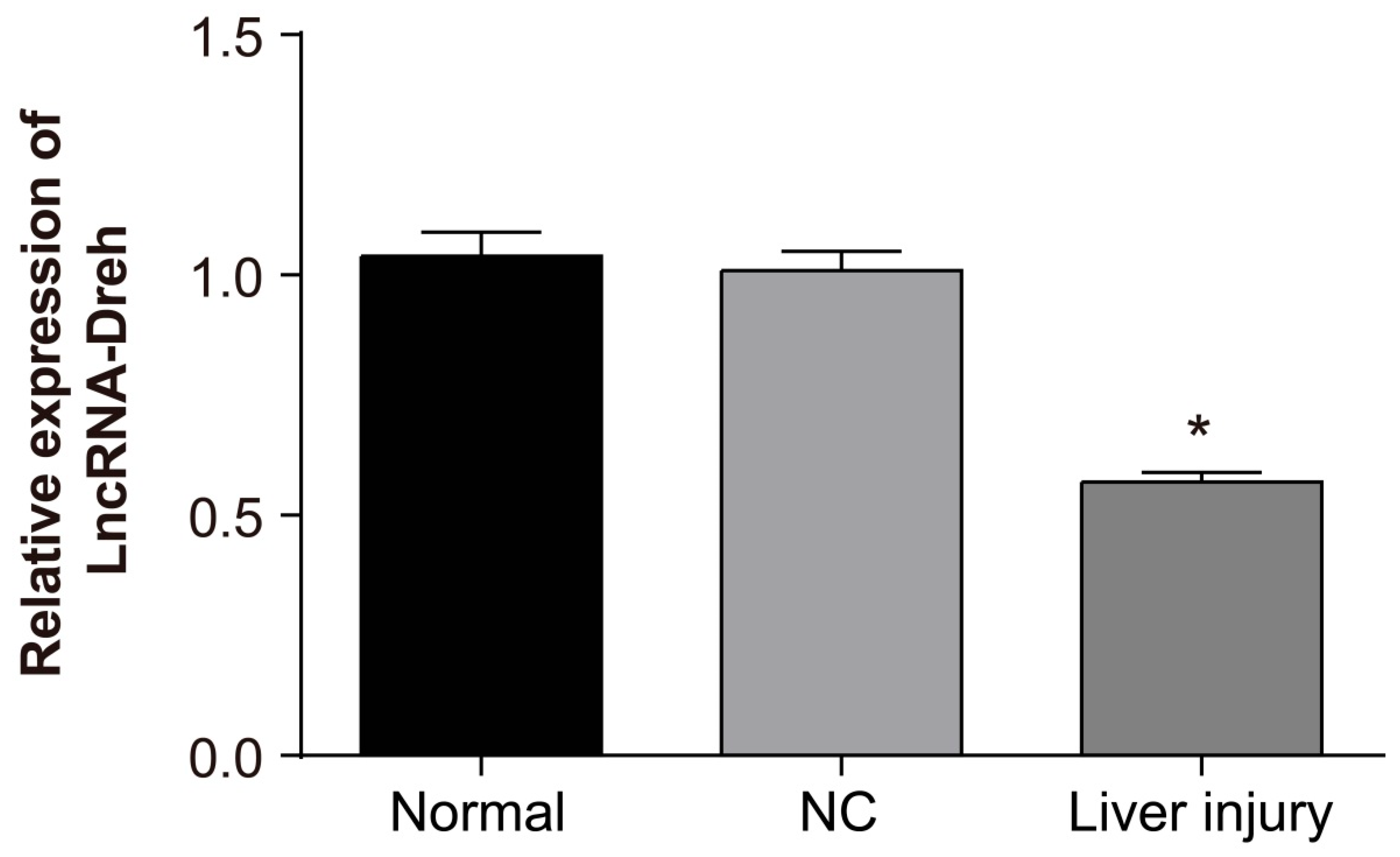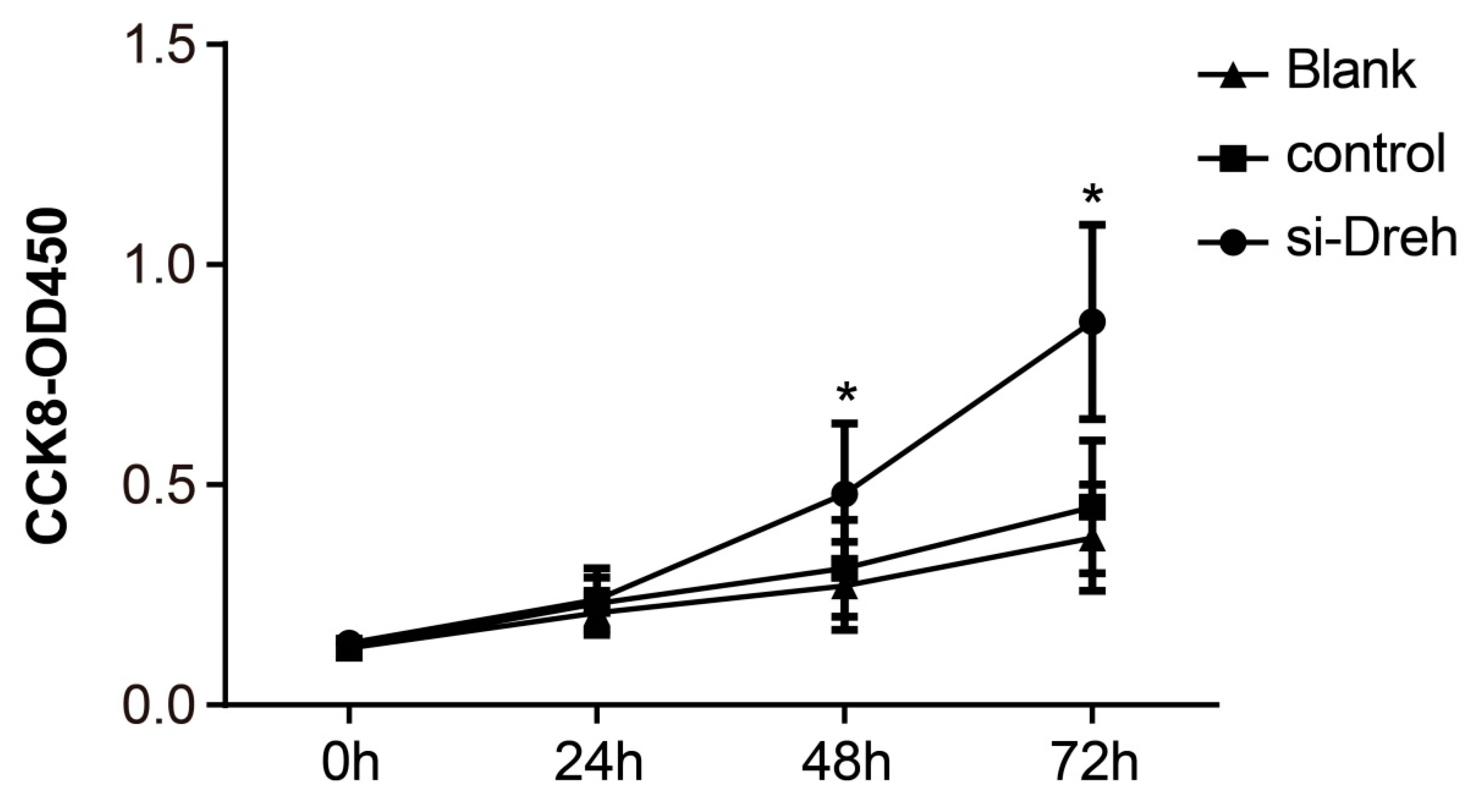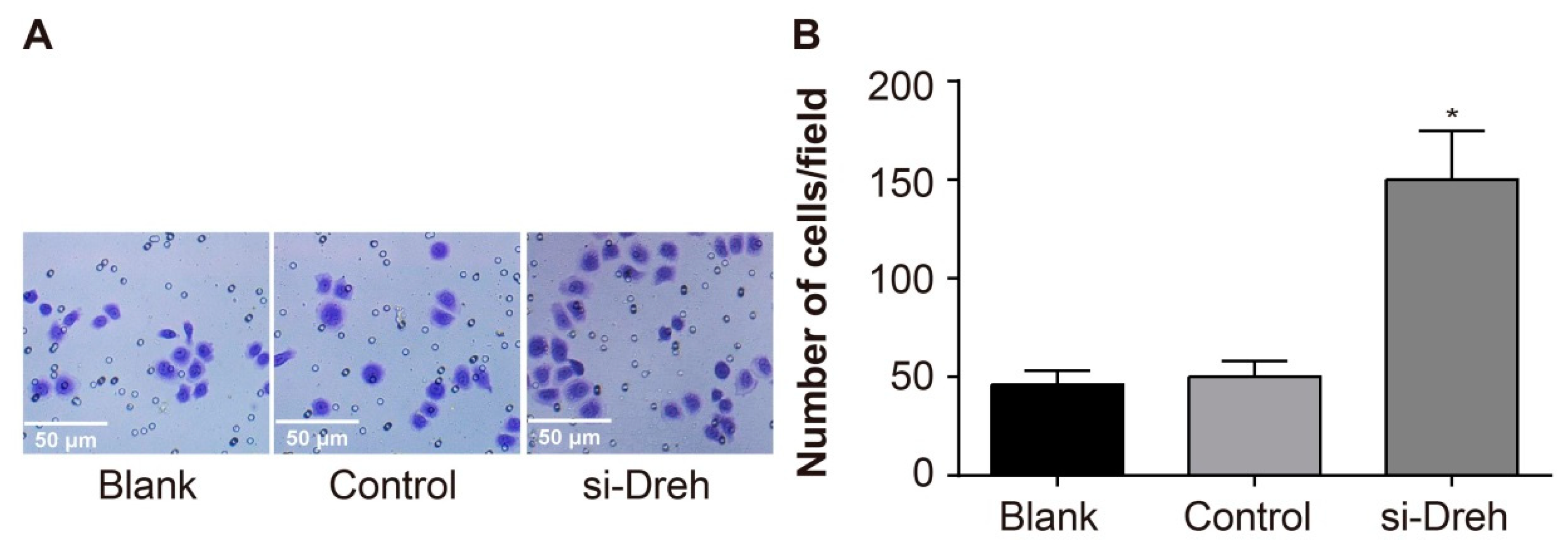RETRACTED: Regulation of Long Non-Coding RNA-Dreh Involved in Proliferation and Migration of Hepatic Progenitor Cells during Liver Regeneration in Rats
Abstract
1. Introduction
2. Results
2.1. The Morphological Changes of Rat HPCs
2.2. LncRNA-Dreh is Down-Regulated in Liver Tissues of Rats with Liver Injury
2.3. Vimentin is Up-Regulated in Liver Tissues of Rats with Liver Injury
2.4. Silencing of LncRNA-Dreh Promotes Proliferation of HPCs
2.5. Silencing of LncRNA-Dreh Promotes Migration of HPCs
2.6. Silencing of LncRNA-Dreh Promotes the Vimentin Expression of HPCs
2.7. Silencing of LncRNA-Dreh Decreases Synthesis of ALB and Enhances Synthesis of AFP in HPCs during Differentiation
3. Discussion
4. Materials and Methods
4.1. Ethical Statements
4.2. Model Establishment
4.3. Hematoxylin-Eosin (HE) Staining
4.4. Cell Culture and Grouping
4.5. Reverse Transcription Quantitative Polymerase Chain Reaction (RT-qPCR)
4.6. Western Blot Analysis
4.7. Cell Counting Kit-8 (CCK-8) Assay
4.8. Transwell Assay
4.9. Detection of Albumin (ALB) and Alpha Fetoprotein (AFP)
4.10. Statistical Analysis
5. Conclusions
Author Contributions
Funding
Acknowledgments
Conflicts of Interest
References
- Michalopoulos, G.K. Hepatostat: Liver regeneration and normal liver tissue maintenance. Hepatology 2017, 65, 1384–1392. [Google Scholar] [CrossRef]
- Mao, S.A.; Glorioso, J.M.; Nyberg, S.L. Liver regeneration. Transl. Res. 2014, 163, 352–362. [Google Scholar] [CrossRef]
- Kogure, T.; Yan, I.K.; Lin, W.L.; Patel, T. Extracellular Vesicle-Mediated Transfer of a Novel Long Noncoding RNA TUC339: A Mechanism of Intercellular Signaling in Human Hepatocellular Cancer. Genes Cancer 2013, 4, 261–272. [Google Scholar] [CrossRef] [PubMed]
- Van Haele, M.; Roskams, T. Hepatic Progenitor Cells: An Update. Gastroenterol. Clin. North Am. 2017, 46, 409–420. [Google Scholar] [CrossRef] [PubMed]
- Li, J.; Jin, W.; Qin, Y.; Zhao, W.; Chang, C.; Xu, C. Expression Profile and Function Analysis of LncRNAs during Priming Phase of Rat Liver Regeneration. PLoS ONE 2016, 11, e0156128. [Google Scholar] [CrossRef]
- Achawanantakun, R.; Chen, J.; Sun, Y.; Zhang, Y. LncRNA-ID: Long non-coding RNA IDentification using balanced random forests. Bioinformatics 2015, 31, 3897–3905. [Google Scholar] [CrossRef]
- Slaby, O.; Laga, R.; Sedlacek, O. Therapeutic targeting of non-coding RNAs in cancer. Biochem. J. 2017, 14, 4219–4251. [Google Scholar] [CrossRef] [PubMed]
- Ji, X.; Zhang, Q.; Du, Y.; Liu, W.; Li, Z.; Hou, X.; Cao, G. Somatic mutations; viral integration and epigenetic modification in the evolution of hepatitis B virus-induced hepatocellular carcinoma. Curr. Genomics 2014, 15, 469–480. [Google Scholar] [CrossRef]
- Huang, J.F.; Guo, Y.J.; Zhao, C.X.; Yuan, S.X.; Wang, Y.; Tang, G.N.; Zhou, W.P.; Sun, S.H. Hepatitis B virus X protein (HBx)-related long noncoding RNA (lncRNA) down-regulated expression by HBx (Dreh) inhibits hepatocellular carcinoma metastasis by targeting the intermediate filament protein vimentin. Hepatology 2013, 57, 1882–1892. [Google Scholar] [CrossRef]
- Mayr, C.; Helm, K.; Jakab, M.; Ritter, M.; Shrestha, R.; Makaju, R.; Wagner, A.; Pichler, M.; Beyreis, M.; Staettner, S.; et al. The histone methyltransferase G9a: A new therapeutic target in biliary tract cancer. Hum. Pathol. 2018, 72, 117–126. [Google Scholar] [CrossRef] [PubMed]
- Katoonizadeh, A.; Poustchi, H.; Malekzadeh, R. Hepatic progenitor cells in liver regeneration: Current advances and clinical perspectives. Liver Int. 2014, 34, 1464–1472. [Google Scholar] [CrossRef] [PubMed]
- Yi, P.S.; Zhang, M.; Xu, M.Q. Role of microRNA in liver regeneration. Hepatobiliary Pancreat. Dis. Int. 2016, 15, 141–146. [Google Scholar] [CrossRef]
- Kaur, S.; Siddiqui, H.; Bhat, M.H. Hepatic Progenitor Cells in Action: Liver Regeneration or Fibrosis? Am. J. Pathol. 2015, 185, 2342–2350. [Google Scholar] [CrossRef]
- Hubel, E.; Saroha, A.; Park, W.J.; Pewzner-Jung, Y.; Lavoie, E.G.; Futerman, A.H.; Bruck, R.; Fishman, S.; Dranoff, J.A.; Shibolet, O.; et al. Sortilin Deficiency Reduces Ductular Reaction, Hepatocyte Apoptosis, and Liver Fibrosis in Cholestatic-Induced LiverInjury. Am. J. Pathol. 2017, 187, 122–133. [Google Scholar] [CrossRef]
- Chien, C.S.; Chen, Y.H.; Chen, H.L.; Wang, C.P.; Wu, S.H.; Ho, S.L.; Huang, W.C.; Yu, C.H.; Chang, M.H. Cells responsible for liver mass regeneration in rats with 2-acetylaminofluorene/partial hepatectomy injury. J. Biomed. Sci. 2018, 25, 39. [Google Scholar] [CrossRef] [PubMed]
- Bria, A.; Marda, J.; Zhou, J.; Sun, X.; Cao, Q.; Petersen, B.E.; Pi, L. Hepatic progenitor cell activation in liver repair. Liver Res. 2017, 1, 81–87. [Google Scholar] [CrossRef] [PubMed]
- Huarte, M. The emerging role of lncRNAs in cancer. Nat. Med. 2015, 21, 1253–1261. [Google Scholar] [CrossRef]
- Zhang, Y.; Xu, Y.; Feng, L.; Li, F.; Sun, Z.; Wu, T.; Shi, X.; Li, J.; Li, X. Comprehensive characterization of lncRNA-mRNA relatedceRNA network across 12 major cancers. Oncotarget 2016, 7, 64148–64167. [Google Scholar]
- Li, J.; Meng, H.; Bai, Y.; Wang, K. Regulation of lncRNA and Its Role in Cancer Metastasis. Oncol. Res. 2016, 23, 205–217. [Google Scholar] [CrossRef]
- Bollong, M.J.; Pietilä, M.; Pearson, A.D.; Sarkar, T.R.; Ahmad, I.; Soundararajan, R.; Lyssiotis, C.A.; Mani, S.A.; Schultz, P.G.; Lairson, L.L. A vimentin binding small molecule leads to mitotic disruption in mesenchymal cancers. Proc. Natl. Acad. Sci. USA 2017, 114, E9903–E9912. [Google Scholar] [CrossRef]
- Mezi, S.; Chiappetta, C.; Carletti, R.; Nardini, A.; Cortesi, E.; Orsi, E.; Piesco, G.; Di Gioia, C. Clinical significance of epithelial-to-mesenchymal transition in laryngeal carcinoma: Its role in the different subsites. Head Neck 2017, 39, 1806–1818. [Google Scholar] [CrossRef]
- Zhou, T.; Gao, Y. Increased expression of LncRNA BANCR and its prognostic significance in human hepatocellular carcinoma. World J. Surg. Oncol. 2016, 14, 8. [Google Scholar] [CrossRef]







| Gene | Primer Sequence |
|---|---|
| LncRNA-Dreh | 5′-GUGCCUGUCACAAACAGAUTT-3′ |
| 5′-AUCUGUUUGUGACAGGCACTT-3′ | |
| Vimentin | 5′-TGGCACGTCTTGACCTTGAA-3′ |
| 5′-GGTCATCGTGATGCTGAGAA-3′ | |
| β-actin | 5′-CTACCTCATGAAGATCCTGACC-3′ |
| 5′-CACAGGATTCCATACCCAAG-3′ |
© 2019 by the authors. Licensee MDPI, Basel, Switzerland. This article is an open access article distributed under the terms and conditions of the Creative Commons Attribution (CC BY) license (http://creativecommons.org/licenses/by/4.0/).
Share and Cite
Ruan, Z.; Lai, M.; Shang, L.; Deng, X.; Su, X. RETRACTED: Regulation of Long Non-Coding RNA-Dreh Involved in Proliferation and Migration of Hepatic Progenitor Cells during Liver Regeneration in Rats. Int. J. Mol. Sci. 2019, 20, 2549. https://doi.org/10.3390/ijms20102549
Ruan Z, Lai M, Shang L, Deng X, Su X. RETRACTED: Regulation of Long Non-Coding RNA-Dreh Involved in Proliferation and Migration of Hepatic Progenitor Cells during Liver Regeneration in Rats. International Journal of Molecular Sciences. 2019; 20(10):2549. https://doi.org/10.3390/ijms20102549
Chicago/Turabian StyleRuan, Zhiyan, Manxiang Lai, Ling Shang, Xiangliang Deng, and Xinguo Su. 2019. "RETRACTED: Regulation of Long Non-Coding RNA-Dreh Involved in Proliferation and Migration of Hepatic Progenitor Cells during Liver Regeneration in Rats" International Journal of Molecular Sciences 20, no. 10: 2549. https://doi.org/10.3390/ijms20102549
APA StyleRuan, Z., Lai, M., Shang, L., Deng, X., & Su, X. (2019). RETRACTED: Regulation of Long Non-Coding RNA-Dreh Involved in Proliferation and Migration of Hepatic Progenitor Cells during Liver Regeneration in Rats. International Journal of Molecular Sciences, 20(10), 2549. https://doi.org/10.3390/ijms20102549





